The School and the Astronomy in Slovenia
(Šola in astronomija v Sloveniji)
Give astronomy a chance
Zorko Vičar
1) Before the International Year of Astronomy 2009 (IYA2009)
Until year 2009 most children in Slovenian schools did not participate in basic Galilean
astronomical
observations of celestial bodies. Astronomy as a theoretical science was (and still is)
thought as part of
different courses at different school levels. Pupils learn something about the North Star
and the Big
Dipper in the third year of primary school. Geography includes lectures on seasons and
tide. Also the
physics is slightly connected with astronomy through mechanics (gravity and rotation)
and through the
Stefan-Boltzmann Law. Part of the secondary (gymnasium, grammar) school pupils had
35 hours of
astronomy up to 1981 and a small population of primary school pupils since 2000
attended an "optional
subject" astronomy. Astronomy is also part of extra-curricular activities (school
astronomical group
with a mentor). Astronomy is also an "optional subject" including three courses of 35
hourse each in
primary schools.
These chapters are:
- Sun, Moon, Earth,
- Binoculars and planets,
- Stars and Space.
Fragmentation and consequently the smallness of primary schools does not allow for
astronomy to be
available as an optional subject to everybody. About 700 (varies from year to year)
primary school
children yearly have astronomy as an optional subject. Astronomy is also available as
extra-curricular
activity - about 10 groups in primary and 8 in secondary schools working regularly. One
or two
research projects in primary and secondary schools are made per year. If we put
together the extracurricular
activities and astronomy as optional subject we get about 1000 pupils involved in
astronomy
in their schools each year. This can be compared with a total number of Slovenian
schools in 2009:
- 165 secondary schools,
- 449 primary schools (to this we have to add 334 branch schools),
- 28 primary schools for children with special needs.
More than 200 000 young people are included in the educational process. The
proportion of young
people involved in astronomy is therefore 1/200. It's only half a percent (0.5%) of
population. Results
of this statistics seem discouraging and modest at first sight. But what do the other
indicators show?
Interestingly, astronomy ranked as the second most frequent choice of pupils in 2001.
The number of
astronomical societies since 1991 has been rising very steeply - from one club (society)
in 1991, to 10
astronomical societies in 2000 and to 18 in 2009. All these signals are showing certain
guidelines and
very positive experience for future development of Slovenian astronomy in schools.
To summarize:
The young people have enough will, also the number of astronomical societies and
observatories is
increasing, and there is interest for astronomy as an optional subject in schools.
I have some experience with the status of school astronomy in other EU states (some
have visited our
Observatory). The situation is generally not significantly better than in Slovenia.
2) In the International Year of Astronomy 2009
What does the International Year of Astronomy 2009 bring? Public astronomical
observations.
It became apparent before 2009 that young people have a much higher astronomical
capacity and
curiosity compared to its realisation in the educational process. Note that during a single
night a few
hour IYA 2009 public observation of Jupiter and the Moon in a town of 200.000
inhabitants was
attended by 5000 people. In some smaller towns the attendance was even 10% to 50%
percent of all
population. These facts show a great desire of people to gain astronomical knowledge
and experience
astronomical observations. These data demonstrate another paradox, namely, that for
most people
hands-on astronomy is more attractive than what schools can offer.
Conclusions could be the following.
It would be reasonable to offer astronomy to at least five to ten percent of the total
population in the
education process. The basic astronomical observations have to be implemented for
entire school
population at least once during the schooling. As an example of a good current practice
- all pupils use
a microscope. Have we learned enough from the IYA2009 to make progress in the field
of school
astronomy? Will the results of IYA2009 still be visible in a few years?
In Slovenia we succeeded to convince the previous government (in July 2008, the
current government
at the end of January 2009) to adopt the initiative of a "Telescope for each school" (also "Telescope for Every School") in
2009. As part of
the IYA2009 therefore the Slovenian Ministry of Education and Sport enables all primary
and
secondary schools in Slovenia to purchase a telescope or other astronomical equipment
of their choice
up to the value of 550 EUR per school (a telescope of 200 mm, f/5 is possible).
The IYA2009 was probably the first and last chance in the entire history of the Slovenian
education,
that schools could be equipped with a useful astronomical equipment, with telescopes,
etc. It is
important to notice that telescopes can work even for a few decades. Many times it
happens that if there
is no enthusiastic teacher at the school, the telescope is not in use (Teachers say: "it
collects dust"). But
when will such enthusiastic teacher appear again, astronomical observations will be alive
again -
because the school telescope exists - and this is one of the our goals, and we have also
the same
experience. Sometimes the students take the initiative and they themselves lead
astronomical
observations, conduct astrophotography etc. We should trust them, but supervision of a
counsellor is
welcome.
A typical comment to the initiative "Telescope for each school" from the web forum:
"It is good and commendable. I still remember when we were in primary school and
secondary school
attending field-trips and lying in middle of the night on our backs and watched the sky ...
in any case,
young people as well as others should now and then look to the stars and think that we
are not the
center of space and get a little sense of perspective. It is a pity that this initiative did not
exist at the
time of my school days."
The initiative is very successful, most of the schools purchased a telescope or additional
astronomical
equipment. According to the first estimates, around 500 (more then 80%) primary and
secondary
schools are buying astronomical equipment - results are not yet final because the
initiative is still going
on.
About the EU? Something like our action has happened in GB - but only for a fourth of
all secondary
schools (telescopes 70 mm, f/10).
3) After the International Year of Astronomy 2009
Will we succeed to include more young people into astronomy education? This primarily
depends on
the current and future Slovenian school policy and on efforts of Slovenian professional
astronomers
and universities. Do we have enough human resources (sufficient number of qualified
educators)? We
do not know the answers but we can make some comments. We estimate that at least
20% of the all
telescopes will be in use and this is the most important. A big breakthrough will happen
in practical
observational astronomy (hitherto neglected). Other telescopes will come into use with a
time lag and
less frequently. 400 years after Galileo Galilei our children will also get a chance to
repeat the proofs
and observations he made. Pupils will see lunar mountains and craters, the planet
Saturn with rings,
Jupiter with moons, Venus with phases similar to that of the Moon, the Milky Way, the
stars and
nebulae, ... All this is crucial and contributed to the development of modern science and
also
fundamentally changed the view of the world (and universe) and the man in it. The
difference between
to believe and to see is huge!
In the past Slovenians have collaborated very actively in the development of astronomy.
Some of the
most important persons are:
Herman of Carinthia in the 12th century, Jurij Vega in the 18th century, Jozef Stefan in
the 19th
century, Herman Potočnik in the 20th century. Three astronauts are of Slovenian origin
(R. Sega, J. M.
Linenger, S. Williams). On the moon we have craters named after J. Stefan and J. Vega.
So there is no
reason to break our rich tradition. 400 years after Galileo it is necessary that astronomy
gets better
incorporated into school system - and the International Year of Astronomy 2009 is a
good opportunity
to do that. Astronomy also teaches us a respect of the nature, beauty of the world and
self-respect.
Let us conclude with a provocative thought:
Children and adults have to return back and enjoy the starry sky. If not, our civilisation
will soon
disappear into the starry sky! Give astronomy a chance.
Appendix
The final results of the initiative "Telescope for each school",
Slovenia - IYA2009, from may to 30th of september 2009:
Number of Number of
purchased telescopes schools Proportion in %
----------------- ------ -----------
406 449 90.4% Primary schools
113 165 68.5% Secondary schools
7 28 25.0% Primary schools for children with special needs
---- ---- ------
TOTAL 526 642 81.9%
The initiative was very
successful, 82% (562) of all
schools have bought a telescope
or additional astronomical equipment.
What pleases us most is that
90 % primary schools have bought a telescope
and also 25 % primary schools for children with special needs.

Figure 1: Number of astronomical societies in Slovenia have risen
by a factor of 18 since 1991.
Prof. of physics, Samo Božič from The National Education Institute
recently carried out a statistical research in some primary schools
that offer astronomy as an optional subject (data were processed by
Vičar Zorko in November 2009). The sample included 26 primary schools
which have offered "Astronomy as an optional subject" (AOS) in the
last triad and which responded to the research questions. We do not
have information about other schools, whether they offered the AOS
to pupils or not, and what was the response. We estimate that the
number of schools, which implement the AOS at present,
is up to 30.
Results on the sample of 26 schools:
Number of schools, which implemented AOS: 16
Number of schools, which offered but not implemented AOS: 10
Number of schools still implementing AOS: 13
Average number of children per group: 13 (maximum 22 children per group)
Number of schools with one group of children attending AOS: 14
Number of schools with two groups of children attending AOS: 2
Number of schools offering astronomy as a extra-curricular activity 8
(schools that offered but not implemented AOS)
Number of schools in which the interest for AOS remains equal: 13
Number of schools in which the interest for AOS is decreasing: 4
Number of schools in which the interest for AOS is increasing: 9 (most of them have 2 or more groups per year)
Based on the above statistics we could speculate and conclude the following.
In schools that have sufficient numbers of pupils in classes or more classes per year,
the probability to implement the AOS is up to 50%. In schools, which offered the AOS,
the interest for astronomy remains the same in 50% of them; in 35% of them
the interest increases, and in 15% it decreases. In schools, which implement
AOS, the interest is decreasing only in one case. The most interesting result
is that in most schools, where they did not collect enough children for the OAS,
they offer astronomy as an extra-curricular activity (this holds for schools
which participated in this research).
Figure 2: Left: Very successful public astronomical observations in a kindergarten in
Vodice on Sep 28th 2009 - during IYA2009. Right: A pupil from primary school Šentvid pri
Stični learns how to use a telescope - May 29th 2009, AD Vega, IYA2009.
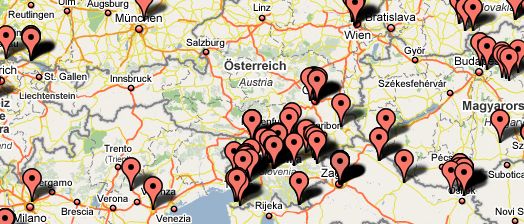
Figure 3: During the world-wide IYA2009 project “100 hours of Astronomy” there were a number of
public astronomical observations organized in Slovenia - significantly more than
in some neighbouring countries.
Possible reasons why more schools do not offer the AOS could be: small schools
and/or small classes, specific environment, teachers, who do not have experience
and therefore not teach AOS, no suitable equipment, other reasons. In any case,
there remains a problem with small primary schools, and they represent around
50% of all schools! On a small primary school, a solution is astronomy as an
extra-curricular activity. We estimate that AOS could be implemented in up to
25% of all primary schools. Currently AOS is implemented only in 0.5 to 1%
of primary school (between 20 and 30 schools, numbers vary from year to year).
How many primary schools, out of the total 449, will in fact implement AOS in
the future and whether our generalizations are correct, remains to be seen.
Optimism does no harm.
Professor Zorko Vičar
Gimnazija Šentvid
Ljubljana, Slovenia
Slovenia and space: yesterday, today and tomorrow
Slovenija in vesolje: včeraj, danes in jutri
Slovenija, Ljubljana, 20-21/10/2009, Tuesday 20th October 2009, Wednesday 21th October 2009
A workshop was held at the University of Ljubljana,
Faculty of Mathematics and Physics,
Jadranska 19, Ljubljana
Purpose
The workshop is organized by the Faculty of Mathematics and Physics
of the University of Ljubljana in
collaboration with the Ministry for Higher Education, Science and
Technology. The purpose is to bring
together the local space-related scientific and technological
community in view of the activities of
Slovenia to become an European Cooperating State of the
European Space Agency.
Namen
Delovno srečanje organizira Fakulteta za matematiko in fiziko Univerze v Ljubljani v sodelovanju z
Ministrstvom za visoko šolstvo, znanost in tehnologijo. Ob skorajšnji slovenski pridružitvi Evropski
vesoljski agenciji je namen delavnega srečanja krepitev vezi v lokalni znanstveni in tehnološki srenji
raziskovalcev, povezanih z vesoljem.
*
View the original document.
*
View the original final document (slovenija_in_vesolje_zbornik_2009.pdf).
http://www.astronomija2009.si/images/stories/mla/aktualna_obvestila/slovenija_in_vesolje_zbornik_2009.pdf
*
ppt - neobdelana verzija
----------------
Back
Nekaj utrinkov iz kongresa.

Slovenec iz ESA-e - Marcos Bavdaž Cosmic Visions 2015-2025 and its technology preparation



Andreja Gomboc Swift, Fermi and the Gamma Ray bursts

Tomaž Zwitter Gaia, ELSA and the RAVE survey

Andrej Prša, Towards Accurate Eclipsing Binary Models in the Kepler
High-Precision Photometry Era

Andrej Čadež and Uroš Kostić, Quantum astronomy and time
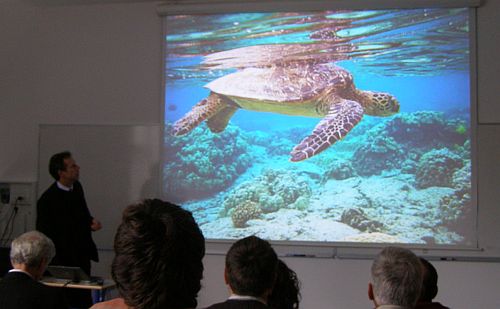
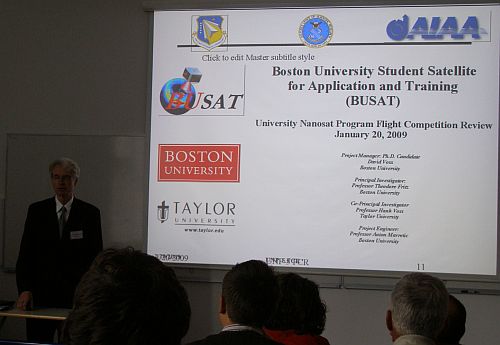
Anton Mavretič, Possible Small Satellite Development in Slovenia

Matjaž Vidmar, TBD [ESMO/overview of satellite projects so far]
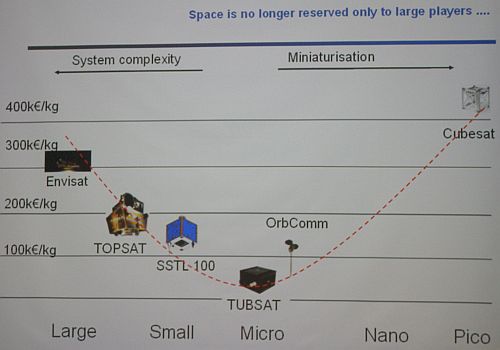

Dušan Petrač, Infrared Astronomical Satellite - IRAS

Herman Mikuž, Črni Vrh Observatory

Boris Kham, Starry sky through exhibitions and on radio waves

The chairman - Jure Longika
Round table discussion: Space sciences and media. Led by
leading Slovenian journalists reporting frequently on the topic.
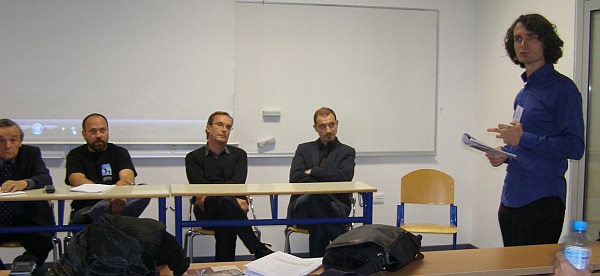
The chairman - Jure Longika
Round table discussion: Space sciences and media. Led by
leading Slovenian journalists reporting frequently on the topic.
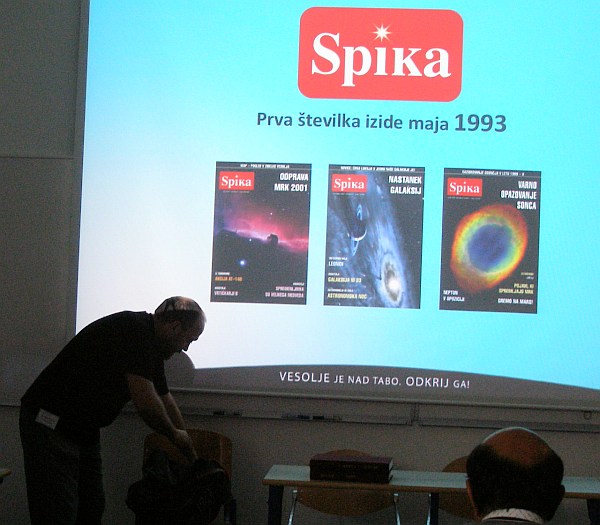
Andrej Guštin (and Bojan Kambič),
Spika astronomical journal

Closing of the Workshop by the Slovenian Minister for Higher
Education, Science and Technology, Mr. Gregor Golobič

Anton Špenko, Slovenian amateur astronomy

Sandi Sitar, Slovenci segajo po zvezdah
Zgornje slike je posnel Zorko Vičar.

Udeleženci srečanja "Slovenija in vesolje: včeraj, danes, jutri"
(Slovenia and space: yesterday, today and tomorrow), 20. in 21.
oktober 2009, Univerza v Ljubljani, Fakulteta za matematiko in fiziko,
Jadranska 19, Ljubljana, Slovenija.
Foto: Andrej Guštin, 21. 10. 2009.
Draft Programme of the Workshop
Slovenia and space: yesterday, today and tomorrow
to be held at the University of Ljubljana, Faculty of Mathematics and Physics,
Jadranska 19, Ljubljana
The thread moves from outer space, towards the Earth, technology, past achievements,
society outreach, and overview of the local facilities.
Day 1, Tuesday 20th October 2009
09.00-09.10 Andrej Likar Welcome by the Dean of the Faculty of Mathematics and Physics
09.10-09.30 Aleš Mihelič Introduction by the Director of the Directorate for Technology of
the Ministry for Higher Education, Science and Technology
09.30-10.00 Marcos Bavdaž Cosmic Visions 2015-2025 and its technology preparation
10.00-10.20 Radovan Pajntar Summary of the hearings conducted by ESA in May 2009
coffee break
Astrophysics and Physics of the Atmosphere
10.50-11.10 Andreja Gomboc Swift, Fermi and the Gamma Ray bursts
11.10-11.30 Tomaž Zwitter Gaia, ELSA and the RAVE survey
11.30-11.50 Andrej Prša Towards Accurate Eclipsing Binary Models in the Kepler
High-Precision Photometry Era
11.50-12.10 Andrej Čadež and
Uroš Kostić
Quantum astronomy and time
12.10-12.30 Vida Žigman Modelling the impact of Solar X -ray flares on the Earth lower
ionosphere
12.30-13.00 Nedjeljka Žagar On a bit of universe trapped to the Earth: our living atmosphere
lunch
Space technologies and its implications
14.00-14.20 Marcos Bavdaž X-ray optics and high energy astrophysics
14.20-14.40 Anton Mavretič Possible Small Satellite Development in Slovenia
14.40-15.00 Matevž Dular Fluid Dynamics and Space
15.00-15.20 Sašo Blažič,
Gregor Klančar,
SIFT features based attitude control of a satellite
Gašper Mušič,
Drago Matko
15.20-15.40 Matjaž Vidmar TBD [ESMO/overview of satellite projects so far]
15.40-16.00 Iztok Kramberger A Survey of On-board Data Handling for the ESMO mission
16.00-16.20 Tomaž Šuštar,
A. Grm,
Tomaž Rodič
M5 computations in space sciences and technologies
coffee break
16.50-17.10 Igor B. Mekjavič Development of Space Medicine in Slovenia
17.10-17.30 Boštjan Šimunič
and Rado Pišot
Effects of Simulated Weightlessness on Human Organism:
Valdoltra Bed Rest Studies 2006-2008
17.30-17.50 Krištof Oštir Satellite Remote Sensing in Slovenia
17.50-18.10 Grega Milčinski Sinergise - TBD
20.00 - social dinner in a downtown restaurant
Day 2, Wednesday 21st October 2009
Past achievements
09.00-09.30 Dušan Petrač Infrared Astronomical Satellite – IRAS
New Window into the Universe
09.30-10.00 Anton Mavretič Voyager I and II, IMP H and J, Wind, and DSX Missions
Mission to the outer planets and near Earth environment
10.00-10.20 Sandi Sitar Slovenci segajo po zvezdah
coffee break
Space Sciences outreach
10.40-11.00 Uroš Kostić and
Andreja Gomboc
International Year of Astronomy in Slovenia
11.00-11.20 Zorko Vičar The School and the Astronomy in Slovenia
11.20-11.40 Boris Kham Starry sky through exhibitions and on radio waves
11.40-12.00 Helena Drnovšek-
Zorko
Third culture and the role of the Ministry of Foreign Affairs
12.00-13.00 Round table discussion: Space sciences and media. Led by
leading Slovenian journalists reporting frequently on the topic.
lunch
Amateur astronomy and astronomical education in Slovenia
14.00-14.20 Andrej Mohar and
Erika Pogačnik
Protecting against light pollution in Slovenia
14.20-14.40 Anton Špenko Slovenian amateur astronomy
14.40-15.00 Herman Mikuž Črni Vrh Observatory
15.00-15.20 Bojan Kambič
and Andrej Guštin
Spika astronomical journal
15.20-15.40 Tomaž Zwitter
and Andrej Čadež
Studying astronomy in Slovenia
15.40-16.00 Aleš Mihelič Summary of the Workshop
16.00- Closing of the Workshop by the Slovenian Minister for Higher
Education, Science and Technology, Mr. Gregor Golobič
Contacts: tomaz.zwitter[@]fmf.uni-lj.si, andreja.gomboc[@]fmf.uni-lj.si


























